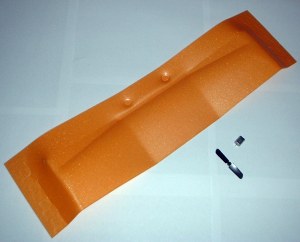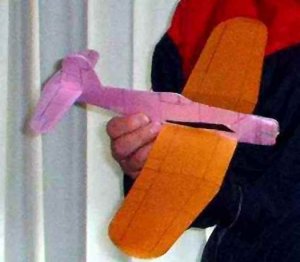
An Aeronautics Challenge You know how it starts; "Dave what are you building for the indoor"? Well I'm dusting off the Lightstick and finally building my IFO. Should be enough for the first time out. Here Dave, why don't you think about making a small free flight electric powered model? Here are the parts you need; There were a molded foam sheet 17 inch wing with a flat center section and dihedral tip sections, a minute N20 motor and 3 inch prop.

"Should be able to build a model light enough to fly with two 50 mah nicad cells". There are a variety of Nocal profile scale designs on the web, why not make a Hurricane? "Oh come on Dick, it is hard enough to finish the IFO and Litestick as well as get all the stuff ready to load and fly." By Friday morning (the day of the meet) I was well enough along to think about it. First of all that wing is ideal for a Corsair. One cut in the middle, a little sanding and glue it back together so I began the search on the web for what I needed. First the Nocal plan. I found one on the Ezone download area; www.ezonemag.com.

Scale it up to 16 inches span, easy. Print it out and cut and glue the wing. Hey, I have started to build it! Quick cut out the stab and fuselage from thin sheet foam. Need to put some doublers in the usual forward fuselage area, how about that, I can bury the motor. Wow, its finished.

Wonder if it will fly? Now I 'fessed up to Dick that I had done it. What does it weigh he said. 24 grams says I. Should fly says he. So it was that at the first Propstoppers indoor I had a Corsair free flight model. It didn't quite fly, it was stable and did impressive long powered turns to the ground. What now Doc? This really bothered Dick as he prides himself on doing the analysis ahead of time so the event is less of a crap shoot. This one he said would fly. Oh well, we have a month before we try again. Not good enough for the Doc. A couple of days later he called to say that he was wrong with the prop and he had another for me to try. Well it's a calm day why don't we try it outdoors this afternoon at the ball field by the school? Fantastic, after a few trimming attempts a little too much charge and away it went circling slowly up and up until it was flying over the tall trees. Oh oh, I am allergic to trees, but it clipped the top branch and fell through to the ground. There were two more giggling little kids on the field that day. The lady with the dog was amused to find that their combined age was somewhere over a hundred! Its still magic folks, a new plane that flies unexpectedly well, no matter how big or uncomplicated. We were high for the rest of the day!
I thought about that feeling, how we all experience it occasionally with a new plane so I decided to write a piece on it. You know, the description of the "kit of parts" etc. but I had used up the parts and didn't have a picture so I asked Dick if he had another wing, motor and prop. Yes, actually he had bought a pack of six wings and 10 motors from Takeoff2000, so I could have some more. I picked them up the next day. Meanwhile I got the e-mail inviting us to the Delaware club indoor meet on the 18th; four days away! First I wanted to finish the Corsair so that its looks matched the flight performance. Magic marker finish was a disaster so I bought some foam safe enamel and printed some markings from the computer.

But you know how it goes with this hobby, you dream of airplanes you would like to build and challenges you would like to take. The gray matter processed this and using the "Racer's Credo" I thought, If one wing and one motor is good (very good) then two motors with two wings is better. In no time the mind was sorting the alternatives. Actually the scale effect obeys the "square - cube law". For now let's just say that when airplanes get twice as big they get more than twice as heavy and require a lot more than twice the power. In the case in point, I intended to join two wings so the span would be double but the chord would only increase slightly however the weight would be more than double so the wing loading and therefore the flight speed would increase somewhat. Double the area and higher flight speed certainly means more than twice the power so I began to think about four motor planes.
I have been developing an 80 inch B-24 but that has a very high aspect ratio wing and that did not fit the form factor of the foam wings and in any case high aspect ratio wings would be heavier. The B-17 has a low aspect ratio wing (which is one of the reasons it had less performance than the B-24) but it has a circular fuselage and by now I was not thinking profile. How about a Lancaster? Quick search on the web found a three view and a vast array of photos.

Wow, what a simple slab sided fuselage. Piece of cake. Hmmm. Could I? Sure, I have four days! What I'll do is make it as light as I can so I can use two motors if they are enough but provisions for four if needed.
I joined the foam wings and added some sheet foam to complete the wing planform. The fuselage was made in the conventional way with a combination of 1/16 in balsa sheet and foam for the sides with thick foam top and bottom hollowed to shape with a shaped tool in a soldering iron. Empenage is from balsa with foam control surfaces. The nacelles are carved from foam and split horizontally at the thrust line to aid motor installation and wiring. I planned to install the motors and wiring into the inner nacelles but leave the outer nacelles empty.


By Monday the 17th it was beginning to take shape and I began to wonder "would it fly"? By now I was up to 60 grams. What I needed was a test flying session but the weather had turned sour. As luck would have it my grandson was attending his seminar class with the teacher who teaches aeronautics in one of her units. She also runs the Science Olympics at the grade school and our family have helped her on many occasions (in fact I have had four grandsons in her class, two currently). So I made a written proposal to fly in their gym after school and that is what I did. I confirmed the flight performance of the Corsair then made several attempts with the Lancaster. The CG was off initially but after a few tries I got it right and tried a somewhat powered flight. It made one large gentle turning descent to a satisfactory landing. Houston, we have a program. I thought that with a fully charged battery pack (using three cells this time) I would have the power to fly on two motors. But now the model cried out to be finished. Of course, I will need spinners or it wouldn't look right, and canopies too, five of them! What to do? Still need to keep it light. I made the spinners by turning light celluloid sheet backing plates and then added foam spinners which I formed by sanding. The canopies were made by carving wood patterns then stretching / shrinking blow molded packaging over the patterns with a heat gun and manual labor. You really don't need a vacuum machine.

All of this was immeasurably aided by constant trips to the computer and searches on the web for photos of the part I was making. Was it worth it? You be the judge.

Did it fly? Not quite, at 77 grams with the detail added it made another long gently turning descent. But the wizard, Doc tells me that I still have the wrong props and it should fly. If not I can add the other motors. Of course, there is the Racer's Credo again, so what to do? Add power, and so it was with four cells and the reduced diameter propellers the Lanc flew beautifully, just look at that grin!

If you want to see it fly try this movie and listen carefully at the beginning.
Video for Windows Media Player
![]()